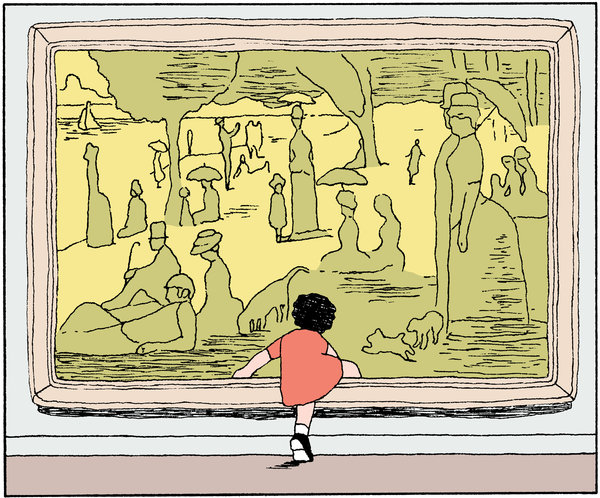Category Archives: Conceptual Framework
Art Makes You Smarter …
Khan Academy Changing Education
Khan Academy is an educational website that, as its tagline puts it, aims to let anyone “learn almost anything—for free.” Students, or anyone interested enough to surf by, can watch some 2,400 videos in which the site’s founder, Salman Khan, chattily discusses principles of math, science, and economics (with a smattering of social science topics thrown in). The videos are decidedly lo-fi, even crude: Generally seven to 14 minutes long, they consist of a voice-over by Khan describing a mathematical concept or explaining how to solve a problem while his hand-scribbled formulas and diagrams appear onscreen. Like the Wizard of Oz, Khan never steps from behind the curtain to appear in a video himself; it’s just Khan’s voice and some scrawly equations. In addition to these videos, the website offers software that generates practice problems and rewards good performance with videogame-like badges—for answering a “streak” of questions correctly, say, or mastering a series of algebra levels. (Carpenter has acquired 52 Earth badges in math, which require hours of toil to attain and at which his classmates gaze with envy and awe.)
Multitasking
Clifford I. Nass, a Stanford University communication professor who studied human interaction with technology and challenged the idea that people can multitask effectively, died on Saturday.
Mr. Nass, 55, was at the Stanford Sierra Camp, near South Lake Tahoe, Calif., for the fall faculty and staff weekend at the time of his death, according to an announcement on the university’s website. He collapsed following a hike, a university official said. The cause of death is unknown.
Mr. Nass had been at Stanford since 1986. He studied the social nature of people’s interactions with technology and, later, the effects of digital multitasking on productivity and social and emotional development.
In 2009, Mr. Nass and two colleagues published a study concluding that people presented with multiple streams of information simultaneously are unable to pay attention or move from one task to another as well as those who executed a single job at a time.
New Technologies for Children Learning STEM/STEAM Subjects and the 21st Century Skills
Think back to when you were a child. Do you remember spending hours building and creating? Did you play with LEGO™s? Maybe you even participated in a robot building contest? How did this experience affect your curiosity and creativity skill?
LEGOs and robotics are being used as a transformative way of learning Science, Technology, Engineering, and Mathematics (STEM) mainly in primary and secondary schools. LEGOs are also being used in pre-schools to develop creativity skills for children. Research has shown that the use of educational robotics increases students’ academic achievement in specific STEM concept areas and promotes cooperative learning and problem solving skills. Some studies also underscore robotics’ potential to engage females and underserved youth in learning STEM subjects.
Similarly, new technologies in computer programming and electronics are transforming the way that students learn how to work in these fields, as well as improving their problem solving and creativity skills. Delivery mechanisms of these technologies also help children learn not only STEM subjects but also art and design (jointly called “STEAM”, A for Art). And the fact that many of these tools are built on an open source platform allows teachers to create a community of practice and to learn from each other.
Vancouver Library Inspiration Lab
CDI and DBR
This little paper was prepared as part of the Alberta Distance Education Review. All rights belong to Carbol and Associates and Alberta Education.
Using A Challenge Driven Innovation Approach and Design Based Thinking
Harvard’s Innovative site
Inspired teaching
Our Mission
Center for Inspired Teaching is building a better school experience for children through innovative teacher training.
Our Model
Central to Inspired Teaching’s professional development is a process that encourages teachers to rethink their role. We’re committed to ending the practice of “delivering” professional development to teachers. We’re working toward making teachers full collaborators in school improvement and reform strategies.
• • •
Inspired Teaching’s professional development model is supported by evidence-based research about how people learn. Our programs are based in best practices in teacher education and in the belief that every student possesses the ability to think critically, understand information, and solve complex problems. Inspired Teachers are Instigators of Thought who teach students how to think, not what to think. Inspired Teachers engage students in the Wonder-Experiment-Learn cycle and embrace the 5 Core Elements of Inspired Teaching and the 4 I’s: Intellect, Inquiry, Imagination, and Integrity.
Sugata Mitra – 5 fav Ted Talks
http://www.ted.com/playlists/89/sugata_mitra_s_5_favorite_educ.html?utm_source=newsletter_weekly_2013-05-03&utm_campaign=newsletter_weekly&utm_medium=email&utm_content=playlist_button

